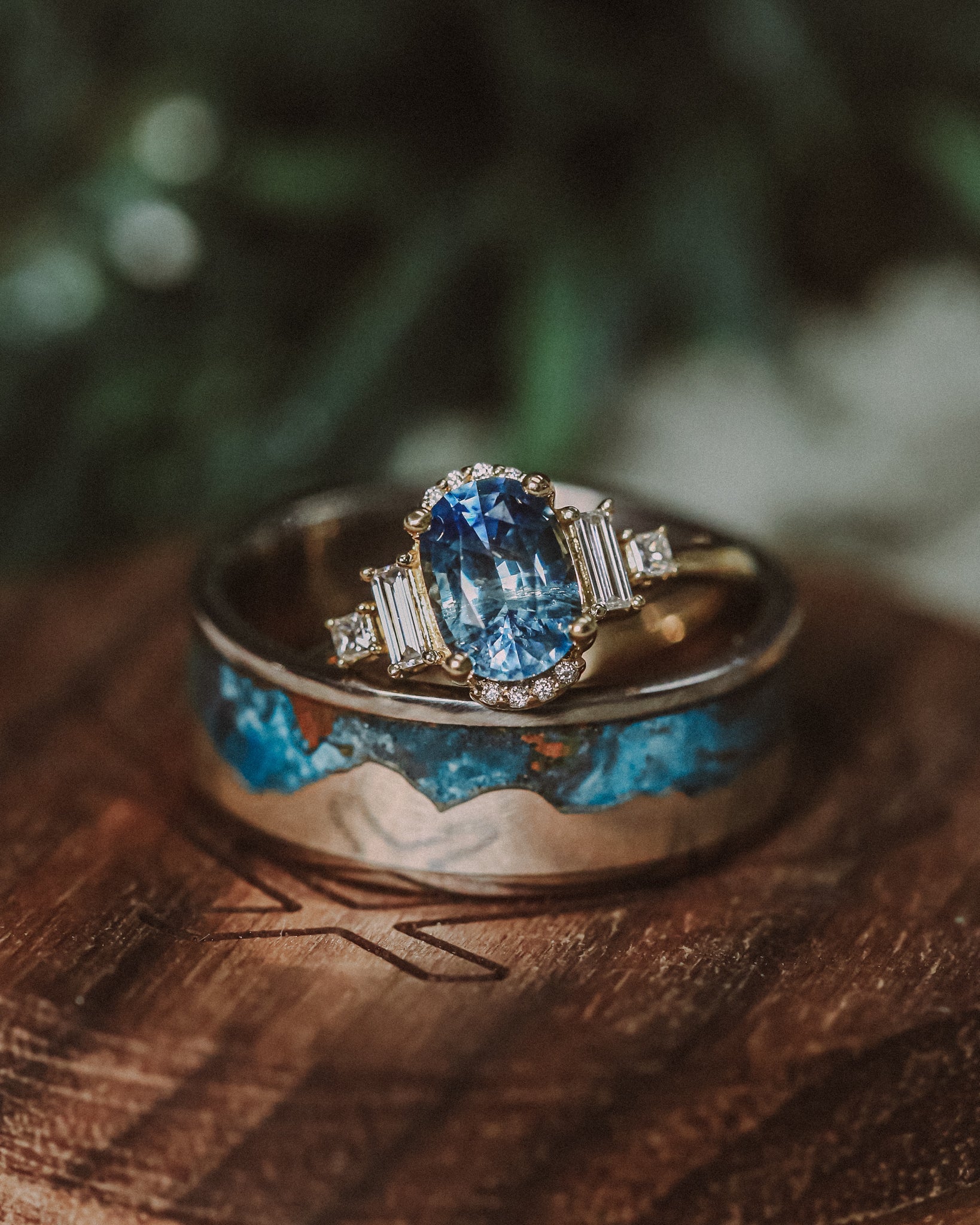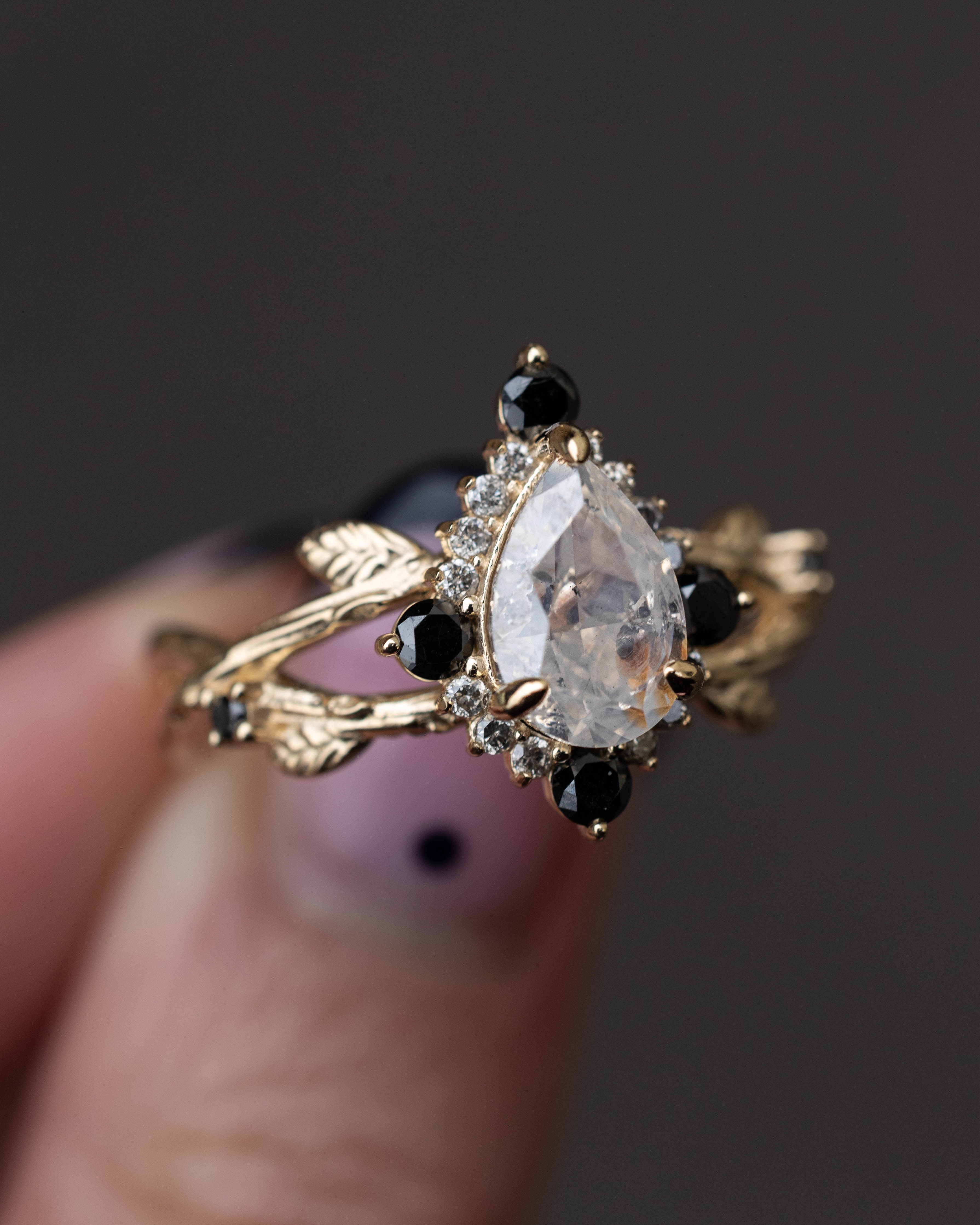| Moss Agate |
None |
Moss agate ranks 6.5-7 on the Moh's scale, indicating fair to good hardness. It lacks defined cleavage, making it resistant to fracturing. |
| Sapphire |
Heat |
Ranking 9 on the Moh's scale, which signifies excellent hardness. It has no cleavage, ensuring high resistance to fracturing. Heating can serve to enhance or remove particular colors, eliminate or minimize inclusions, or create a more uniform coloring. Heating can also happen naturally beneath the earth’s crust. |
| Salt and Pepper Diamond |
None |
While they are just as hard as an eye clean diamond, avoid exposing them to unnecessary force or impact, as these diamonds may have inclusions that could be more susceptible to damage. Avoid exposing your salt and pepper diamond to extreme temperatures, as sudden changes can lead to stress on the stone. |
| Turquoise |
None |
Turquoise ranks a 5-6 on the Moh's scale with fair to good toughness. It's generally stable to light but can discolor and sustain surface damage under high heat. Turquoise dissolves slowly in hydrochloric acid, and it can be discolored by chemicals, cosmetics, and even skin oils or perspiration. |
| Lab-Grown Alexandrite |
None |
Alexandrite scores 8.5 on the Moh's scale, showcasing superior toughness and no cleavage. It remains stable in regular conditions, resisting the impact of heat, light, and common chemicals. |
| Opal |
None |
Opals are commonly shaped into cabochons, featuring a convex top and flat bottom. Given opal's softness (around 6.5 on Moh's hardness scale, similar to glass), it's crucial to handle opal with care to prevent damage.
Additionally, while opal is generally stable, exposure to heat can lead to fracture lines known as "crazing," and high heat or sudden temperature changes can cause fractures. Opal is vulnerable to hydrofluoric acid and alkaline solutions. Some treatment methods include impregnation with oil, wax, or plastic, along with surface modifications like sugar treatment and smoke treatment.
|
| Moissanite |
None |
With a hardness of 9.25 on the Moh's scale, it is highly resistant to scratches, making it suitable for everyday wear. It's best to avoid exposing it to harsh chemicals, including household cleaners and chlorine, which can affect its brilliance over time. |
| Moonstone |
None |
Moonstone rates between 6 and 6.5 on the Moh's scale with poor toughness due to cleavage. High heat or sudden temperature changes can cause breaks. It's stable in light but harmed by exposure to hydrofluoric acid. |
| Sunstone |
None |
Feldspars, like sunstone, are a 6.5 to 7.2 on the Moh's scale and have poor toughness due to cleavage in two directions, making them prone to damage. Despite this, sunstone is an excellent jewelry choice when in a well-protected setting. Avoid exposing sunstone to excess heat, but its color remains stable in light. Hydrochloric acid rapidly affects feldspars, so bleach based cleaning products are not recommended. |
| Labradorite |
None |
Ranking 6 to 6.5, labradorite has poor toughness due to cleavage. Labradorite is generally stable in light, but prolonged exposure to intense sunlight may affect its colors over time. Can be sensitive to acids and chemicals, so it's advisable to avoid contact with substances like acids, bleach, and harsh cleaning chemicals. |
| Morganite |
Heat & Irradiation |
Scoring 7.5 to 8 on the Mohs scale, is durable but requires careful handling to prevent scratches and impacts. Avoid exposing it to heat, but its color remains stable in light. Take caution with hydrofluoric acid, as it will damage morganite. |
| Natural Emerald |
Oiled |
7.5 to 8 on the Moh's scale, emerald is relatively durable. Despite their hardness, emeralds can lack toughness and can be brittle, particularly when the stone is heavily included. It's crucial to avoid abrupt shocks, including thermal and physical impacts.
A significant portion, approximately 90%, of natural emeralds in the market undergo enhancement with oil or resin. |
| Aquamarine |
Heat |
7.5 to 8 on the Moh's scale, aquamarine is durable. Avoid exposing it to heat, although its color remains stable against light exposure. Take caution with hydrofluoric acid, as it can affect aquamarine. |
| Green Beryl |
Oiled |
7.5 to 8 on the Moh's scale, green beryl is relatively durable. Despite their hardness, they can lack toughness and can be brittle, particularly when the stone is heavily included. It's crucial to avoid abrupt shocks, including thermal and physical impacts. Green beryl derives its green hue from iron trace elements. Notably, light-green-colored green beryl lacks vanadium or chromium, distinguishing it from emeralds, even if visually green at first glance. |
| Rose Quartz |
Heat |
Ranking 7 on the Moh's scale, it lacks cleavage, reducing the risk of breaking when struck. Rose quartz exhibits stability under normal wear conditions, resisting the effects of heat, light, and common chemicals. However, it is advised to handle it with care to avoid scratches and hard blows.
|
| Garnet |
None |
Garnet hardness varies (6.5 to 7.5 on the Mohs scale). Almandine, Pyrope, Spessartine, and Tsavorite are harder, while Demantoid is softer. Garnets are fair to good toughness, suitable for all jewelry with proper care. Avoid hard blows and rough wear. Stable to light and chemicals, but vulnerable to hydrofluoric acid.
|
| Amethyst |
Heat |
Amethyst is a 7 on the Moh's scale with good toughness. However, be cautious of abrupt temperature changes, as that can cause fractures. Prolonged exposure to intense light may fade some colors, and amethyst is susceptible to damage from hydrofluoric acid, ammonium fluoride, and alkaline solutions. |
| Prasiolite |
Heat |
Prasiolite, or green amethyst, is a 7 on the Moh's scale with good toughness. However, be cautious of abrupt temperature changes, as that can cause fractures. Prolonged exposure to intense light may fade some colors. Prasiolite is susceptible to damage from hydrofluoric acid, ammonium fluoride, and alkaline solutions. |
| Citrine |
Heat |
With a Mohs scale rating of 7, is durable and suitable for various jewelry types. However, it requires careful handling to prevent scratching. Abrupt temperature changes may cause fractures, and prolonged exposure to intense light can fade some colors. Additionally, citrine is susceptible to damage from hydrofluoric acid, ammonium fluoride, and alkaline solutions. |
| Peridot |
None |
Peridot rates 6.5 to 7 on the Moh's scale with fair to good toughness. Rapid or uneven heat may cause fractures. Peridot is stable in light but susceptible to sulfuric acid and hydrochloric acid. Long-term exposure to acidic perspiration can also affect the stone. |
| Jade |
None |
Jadeite scores 6.5 to 7, and nephrite is 6 to 6.5 on the Moh's scale, requiring care to prevent scratches. Despite this, both gems have exceptional toughness, resisting breaking or chipping. Jade remains stable in light but can be affected by warm acids. |
| Lapis Lazuli |
None |
Lapis ranks between 5 and 6 on the Moh's scale and has fair toughness. Keep it away from harsh chemicals, including household cleaners and beauty products. Prolonged exposure to direct sunlight may cause fading in the color. |
| Tourmaline |
Heat |
Tourmaline rates 7 to 7.5 on the Mohs scale with fair toughness. It's generally stable in light and chemicals, but susceptible to heat damage. High heat can alter its color, and sudden temperature changes may cause fracturing. Some tourmalines undergo color-enhancing treatments, primarily heating and irradiation. Changes from heat treatment are stable and invisible, but gems with liquid inclusions can't withstand it. Color changes from irradiation may fade with heat or bright light exposure. |
| Spinel |
None |
Spinel ranks 8 on the Mohs scale and has good toughness, making it a durable gem for jewelry. High heat can cause some spinel colors to fade, but spinel is stable when exposed to light and chemicals. Some spinel might be subjected to color-altering heat treatment. The treatment is stable under normal wearing conditions. |
| Zircon |
Heat |
Zircon rates 6 to 7.5 on the Mohs scale with fair to good toughness. Zircon can be brittle, so avoid rubbing or hitting the stone on surfaces.
Blue and colorless stones are commonly heat-treated. Generally stable in light, heat-treated stones may revert to their original colors after prolonged bright light exposure. Zircon remains stable in chemical exposure. |
| Tanzanite |
Heat |
Zoisite, known as tanzanite, ranks 6 to 7 on the Mohs scale with fair to poor toughness and cleavage. Tanzanite is stable under normal conditions, resisting heat, light, and common chemicals, but avoid very high temperatures and sudden changes. It's vulnerable to hydrochloric and hydrofluoric acids. Tanzanite is routinely heat-treated to modify its color from a predominately brownish appearance to a predominately blue to purple appearance. The treatment is stable with no additional durability concerns. |
| Topaz |
Irradiation |
Topaz, with basal cleavage, demands special care in cutting, polishing, and mounting. Despite its Moh's hardness of 8, it's not very tough, prone to splitting with a hard blow or breaking under extreme pressure or temperature changes. High heat can cause breaks. Color stability is generally good, but prolonged heat or sunlight exposure may fade certain shades. Topaz is minimally affected by chemicals. Treatments include irradiation and heat. |
| Pearl |
Dyeing, Coatings, and Impregnation |
Pearls, with a Moh's hardness of 2.5, are very soft and easily scratched, but with care, they can be a lasting treasure. Their toughness is generally good, but aging, dehydration, and excessive bleaching can make some more fragile. High heat can burn or damage cultured pearls.
They are generally stable to light, but intense light heat can cause dehydration and cracked nacre. Pearls are vulnerable to damage from various chemicals and acids, including hair spray, perfume, cosmetics, and perspiration. Treatments like dyeing, impregnation, or coating may alter over time. Bleaching and irradiation can be stable during normal wear. For routine care, wipe cultured pearls with a very soft, clean cloth after each wearing. |
| Ruby |
Heat |
Corundum, ruby and sapphire, ranks 9 on the Moh's scale, making it hard and tough with no cleavage, suitable for daily wear in rings. It's stable under normal conditions, resisting heat, light, and common chemicals. Boric acid powder will etch the surface of even untreated stones. Fracture-filled, cavity-filled, and dyed stones can be damaged by mild acids like lemon juice. Untreated and heat-treated corundum is very durable. |





